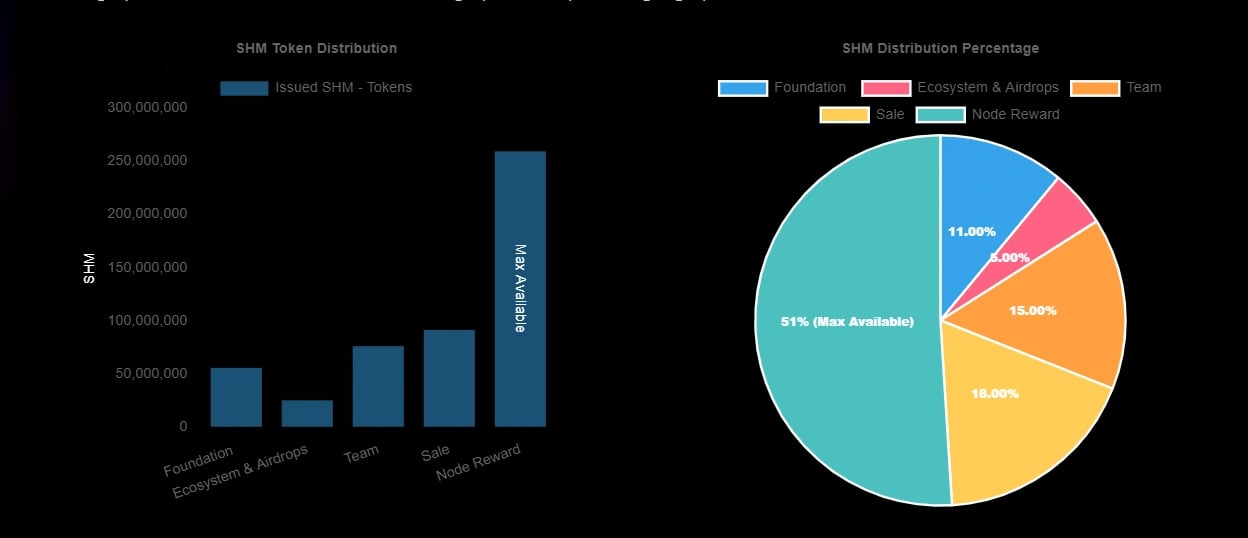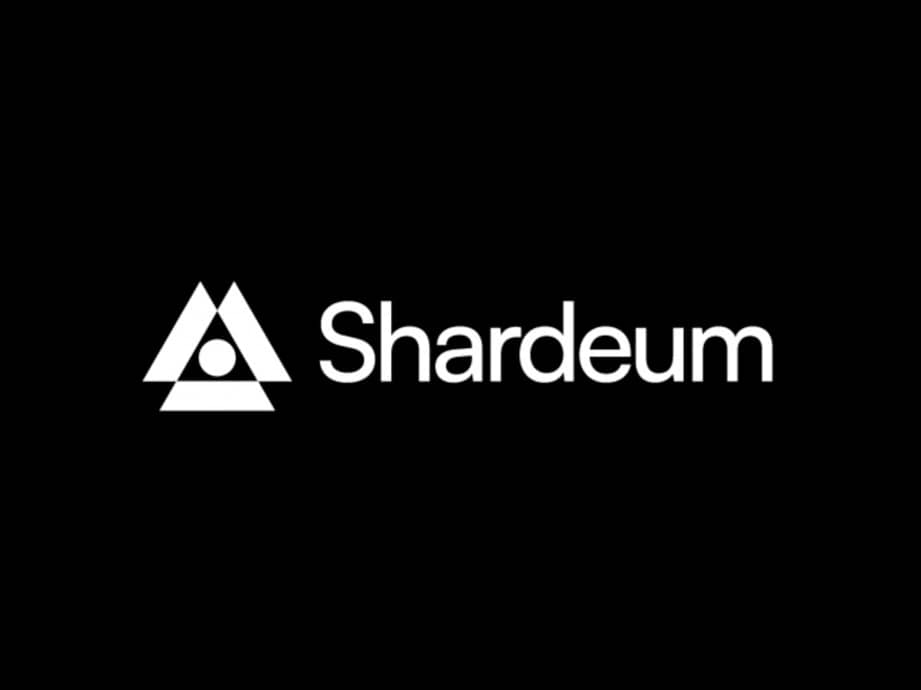위키 구독하기
Share wiki
Bookmark
Shardeum
Shardeum
**샤르둠(Shardeum)**은 이더리움 가상 머신(EVM) 기반의 1계층(L1) 블록체인으로, 블록체인 공간에 동적 상태 샤딩을 도입했습니다. 동적 상태 샤딩을 통해 샤르둠은 선형적인 확장성을 달성하고 네트워크의 모든 조각에서 원자적 합성을 유지하는 것을 목표로 합니다. 이러한 접근 방식은 일관되게 낮은 수수료를 유지하면서 추가 검증자를 수용하여 트랜잭션 처리 용량을 지속적으로 향상시키기 위해 구현되었습니다. [1]
개요
샤르둠(Shardeum)은 2022년 2월에 설립되었으며 2024년 1분기에 공식 출시를 목표로 합니다. 목표 중 하나는 블록체인의 삼각형 딜레마(확장성, 분산성, 보안)를 동시에 달성하는 것입니다. 동적 상태 샤딩 기능을 통해 샤르둠은 각각의 새로운 검증자가 추가될 때마다 확장할 수 있으며, 개발자는 복잡한 샤딩 고려 사항 없이 Solidity 또는 Vyper로 작성된 스마트 계약을 배포하고 상호 작용할 수 있습니다. 계약은 상호 운용성을 유지하면서 고유한 샤드에 자동으로 분산됩니다. 또 다른 주요 기능은 자동 확장 메커니즘으로, 네트워크는 변화하는 작업량에 따라 샤드의 수와 크기를 조정하여 성능을 최적화하고 생태계가 성장함에 따라 지속적인 확장성을 보장합니다. 개방적이고, 협력적이며, 커뮤니티 중심적인 프로젝트라는 핵심 원칙을 바탕으로 샤딩을 통한 확장성과 구성 가능성에 중점을 둡니다. [2][13][14]
2024년 1월, 샤르둠은 분산 애플리케이션(Dapp)의 인프라를 혁신하는 포괄적인 솔루션인 스페론(Spheron)과 파트너십을 맺었습니다. 스페론은 샤르둠 검증자 노드를 지원하며, 사용자는 스페론 UI를 통해 검증자 노드를 설정할 수 있습니다. [15]
주요 특징
동적 상태 샤딩
동적 상태 샤딩은 샤르덤 아키텍처의 핵심 기능입니다. 사전에 샤드 주소 공간을 정의하는 정적 상태 샤딩과 달리, 동적 상태 샤딩은 유연성과 적응력을 제공합니다. 샤르덤과 같은 동적 시스템의 샤드는 네트워크 상태 변화에 따라 필요에 따라 생성 또는 제거될 수 있습니다. 샤드 분할 또는 병합, 노드 재할당 및 중복 관리와 같은 이러한 적응은 실시간 알고리즘에 의해 조정됩니다. 이러한 동적 접근 방식은 샤르덤이 시스템 부하와 사용 가능한 리소스 간의 최적의 균형을 유지하여 효율적이고 안전한 네트워크 운영을 보장할 수 있기를 기대합니다. 샤르덤의 각 검증자는 고유한 주소 범위를 담당하며, 할당된 트랜잭션을 실행하고 해당 상태 변경 사항을 저장합니다. 검증자의 중복 커버리지는 각 주소가 최소 128개의 검증자에 대한 중복성을 갖도록 보장합니다. 이는 하나의 검증자에 문제가 발생하더라도 다른 127개의 검증자가 그 역할을 대신할 수 있음을 의미합니다. [3][4]
트랜잭션 합의
샤르둠은 트랜잭션 검증을 위해 지분 증명(PoS)과 쿼럼 증명(PoQ)을 결합한 하이브리드 합의 메커니즘을 사용합니다. PoS 구성 요소에서 각 검증자 노드는 네트워크에 참여하기 위해 최소량의 SHM(샤르둠의 네이티브 토큰)을 스테이킹해야 합니다. 검증자 노드는 SHM 보상으로 정직하게 트랜잭션을 검증하도록 유인되며, 악의적인 행위는 스테이킹된 SHM이 삭감되어 네트워크 보안이 강화됩니다. [7]
PoQ 측면에서는 다른 네트워크에서 일반적인 블록 수준 합의와 달리 트랜잭션 수준 합의를 도입합니다. 트랜잭션 수준 합의는 즉각적인 최종성과 낮은 지연 시간을 보장하여 네트워크 혼잡을 최소화합니다. 트랜잭션은 수신 즉시 개별적으로 검증되고 타임스탬프가 지정되어 이중 지출을 방지합니다. 트랜잭션 정보는 가십을 통해 샤드 내의 노드 간에 공유되어 신뢰할 수 없고 리더가 없는 전자 투표 또는 영수증 형태의 쿼럼을 구축합니다. 트랜잭션은 전자 투표를 통해 디지털 서명되며, 쿼럼(50% 이상의 영수증)에 도달하면 네트워크에 커밋됩니다. 합의 알고리즘에는 검증자 노드의 자동 회전이 통합되어 악의적인 행위자에 대한 네트워크 보안이 더욱 강화됩니다. [7]
EVM 호환성
샤르둠은 이더리움 가상 머신(EVM, Ethereum Virtual Machine)과 호환됩니다. 이더리움 및 이더리움 기반 개발자에게는 애플리케이션 코드를 변경하지 않고도 샤르둠으로 간편하게 전환할 수 있다는 것을 의미합니다. Solidity 또는 Vyper로 작성된 EVM용 스마트 계약은 샤르둠으로 쉽게 이식할 수 있으므로 증가하는 가스 요금에 대한 우려를 없앨 수 있습니다. [8]
Shardeum Opcodes
Shardeum은 블록 단위가 아닌 개별적으로 트랜잭션을 처리하지만, JSON RPC 사양과 호환되는 기존 스마트 계약을 지원하기 위해 주기적으로 블록을 생성합니다. 블록은 사이클별로 생성되며, 각 사이클은 일반적으로 60초 동안 지속되고 10개의 블록을 생성합니다. 트랜잭션의 타임스탬프는 타임스탬프를 블록 번호에 매핑하여 적절한 블록을 선택합니다. 트랜잭션에 타임스탬프가 없는 경우 네트워크에서 타임스탬프를 할당하고 해당 블록을 선택합니다. Shardeum은 블록 관련 공용 API 엔드포인트를 제공하여 JSON RPC 서버가 네트워크에서 사용하는 것과 동일한 블록 정보에 액세스할 수 있도록 하여 향상된 호환성과 상호 운용성을 제공합니다. [9]
SHM 토큰
SHM은 샤르데움 생태계의 기본 유틸리티 및 거버넌스 토큰으로서 기능합니다. 네트워크의 필수 요소이며 다양한 기능을 제공하고 네트워크 운영에 중요한 역할을 합니다. [10]
공급 및 배포
최대 공급량: 5억 8백만 SHM 배포:
- 커뮤니티 (51%): 검증자, 아카이브 노드 및 대기 서버를 포함한 노드에 대한 지불
- 판매 (18%): 3개월의 대기 기간 후 2년에 걸친 선형적 분배 일정
- 팀 (15%): 3개월의 초기 대기 기간 후 2년에 걸친 선형적 분배 기간
- 재단 (11%): 토큰 생성 이벤트(TGE) 시 해제
- 생태계 및 에어드롭 (5%): TGE 시 해제

유틸리티
채굴 및 보상
SHM 토큰은 검증자 및 아카이브 노드가 Shardeum 네트워크에 대한 기여에 대한 보상으로 채굴합니다. 이러한 기여에는 네트워크 리소스 제공 및 네트워크의 효율적인 운영 보장이 포함됩니다. 이러한 메커니즘은 생태계 내 참여와 리소스 제공을 장려합니다. [10]
가스 수수료 및 스마트 계약
SHM 토큰은 Shardeum 네트워크에서 전송 트랜잭션 실행 및 스마트 계약과 상호 작용에 관련된 가스 수수료 지불에 사용됩니다. 이러한 가스 수수료는 네트워크 운영의 필수적인 부분이며 트랜잭션 실행 및 스마트 계약 배포를 가능하게 합니다. [10]
안정적인 가격 및 거래 수수료
Shardeum은 최근 SHM 가격의 평균으로 계산된 안정적인 가격(Stable Price)을 유지하며, 이는 매일 업데이트됩니다. 이 안정적인 가격은 거래 수수료, 검증자 스테이킹 금액 및 기타 네트워크 관련 값을 결정하는 기준으로 사용됩니다. 이를 통해 SHM 가격 변동성에 관계없이 거래 수수료와 보상이 USD 기준으로 안정적으로 유지됩니다. [10]

S:A 비율
S:A 비율은 네트워크에서 대기 노드와 활성 노드의 비율을 나타냅니다. 대기 노드는 무작위로 선택되어 네트워크에 참여하며, 오랫동안 활성 상태였던 노드는 주기적으로 순환됩니다. 이러한 순환은 트래픽이 많은 기간 동안 확장성을 높이고, 네트워크 분산을 강화하며, 다수 점유 또는 시빌 공격에 대한 복원력을 향상시키는 것을 목표로 합니다. [10]

DAO로의 기반 전환
샤르둠은 탈중앙화를 향한 경로를 따르며, 재단 주도 네트워크에서 탈중앙화 자율 조직(DAO)로 전환됩니다. 초기에는 재단이 제안 또는 투표에 필요한 임계량보다 많은 SHM을 보유하고 있으므로 재단이 통제권을 갖습니다. 그러나 시간이 지남에 따라 커뮤니티 주도 투표를 통해 이 임계량이 감소하여 더 많은 커뮤니티 구성원이 거버넌스에 참여할 수 있게 됩니다. 중앙 집중식 제어에서 완전한 기능을 갖춘 DAO로의 이러한 점진적인 전환은 네트워크 거버넌스의 탈중앙화를 위한 점진적인 전환을 보장합니다.
스핑크스 베타넷
샤르둠의 스핑크스 베타넷은 2023년 2월 2일에 출시되었으며, 샤르둠 리버티로 알려진 알파넷에서의 광범위한 테스트를 거쳤습니다. 이 테스트에는 이더리움 가상 머신(EVM) 호환성 및 샤딩 기능 평가가 포함됩니다. 스핑크스 베타넷은 샤르둠의 공식 메인넷 출시 전 최종 테스트 단계입니다. [5][6]
주요 하이라이트
- 노드 운영자를 위한 사용자 친화적인 GUI/대시보드 생성
- 투명성을 높이기 위해 Shardeum 검증자 및 검증자 대시보드 코드 오픈소싱
- 블록체인에서 상태 샤딩 시연, 크로스-샤드 원자적 합성 가능성을 보여줌
- 개발자 친화적인 환경을 위해 EIP-2930 접근 목록 자동화
- 베타넷에서 35,000명 이상의 검증자 확보, 대규모 분산형 테스트넷 중 하나임을 입증
- 초당 평균 180건의 트랜잭션 처리 용량 유지[6]
커뮤니티 증명
커뮤니티 증명(PoC) 이니셔티브는 Web3 기술과 관련된 인식 제고 및 교육 기회를 제공하기 위해 고안된 일련의 커뮤니티 이벤트를 포함합니다. [15]
이벤트 종류
미팅
이러한 모임은 네트워킹, 학습 및 새로운 업계 동향 탐색을 위한 플랫폼을 제공합니다. 전문가들은 자신의 지식과 통찰력을 공유하며, 잠재적 협력자, 자문가 및 Web3 애호가에게 제품 발표 기회를 제공하기도 합니다. [15]
워크숍
워크숍은 참가자의 기술적 배경에 관계없이 누구나 ERC-20 토큰(ERC-20)(https://iq.wiki/wiki/erc-20) 생성 방법이나 NFT(NFT)(https://iq.wiki/wiki/non-fungible-token-nft) 프로젝트 개발 방법을 배우는 실습 중심의 세션입니다. 업계 전문가들이 안내를 제공하여 참석자들이 귀중한 기술을 습득할 수 있도록 합니다. [15]
캠퍼스
캠퍼스 이벤트는 학생들에게 학습 자료, 보상 및 멘토링 기회를 제공함으로써 학생들을 지원하는 데 중점을 둡니다. 업계 전문가들이 캠퍼스를 방문하여 학생들이 Shardeum 리소스를 사용하여 스마트 계약을 배포하고 애플리케이션을 구축하도록 안내합니다. 또한 학생들은 보상 프로그램, 멘토링 및 홍보대사 활동에 참여하여 Web3 지식과 기술을 향상시킬 수 있습니다. [15]
자금 조달
시드 펀딩 라운드
2022년 10월 18일, 샤르데움(Shardeum)은 전 세계 50개 이상의 ECA(얼리 커뮤니티 및 엔젤) 참여자들의 참여로 시드 펀딩 라운드에서 1,820만 달러를 확보했습니다. 주목할 만한 투자자로는 Jane Street, Big Brain Holdings, Struck Crypto, The Spartan Group, Ghaf Capital, DFG, CoinGecko Ventures, Foresight Ventures, Jsquare, Cogitent Ventures, WeMade, Veris Ventures, ZebPay, Tupix Capital, MapleBlock Capital 등 여러 벤처 캐피털 회사들이 포함됩니다. 이 자금은 샤르데움의 기술 향상, 생태계 개발 및 연구 확장을 위해 마케팅 및 개발팀 규모 확장에 사용될 예정입니다. [16]
엔젤 투자자들 또한 이번 펀딩 라운드에서 중요한 역할을 했습니다. 발라지 스리니바산(Balaji Srinivasan), 마유르 굽타(Kraken CMO) 등이 대표적입니다. 이 라운드는 다수의 ECA 참여자를 포함하는 데 중점을 두었으며, 40% 이상이 엔젤 투자자였습니다. 목표는 소수의 기관에 SHM 토큰이 집중되는 것을 방지하고 광범위한 배포를 보장하는 것이었습니다. [16]
전략적 자금 조달 라운드
2023년 7월 8일, 샤르데움(Shardeum)은 Amber Group, Galxe, J17 Capital, TRGC, Jsquare 등 여러 투자자들의 투자를 포함한 540만 달러 규모의 전략적 자금 조달 라운드를 완료했다고 발표했습니다. 추가 자본은 메인넷 출시를 앞두고 생태계 성장을 더욱 지원하는 데 사용될 예정입니다. 샤르데움의 최고 성장 책임자(Chief Growth Officer)인 켈시 맥과이어(Kelsey McGuire)는 이 전략적 투자 유치가 글로벌하고 다양한 커뮤니티를 육성하려는 그들의 사명을 발전시키는 데 중요하다고 강조했습니다. 이 자금을 통해 탈중앙화를 우선시하고 교육 이니셔티브를 통해 전 세계 참여자들의 커뮤니티를 확장할 수 있게 되었습니다. [17]
“주요 참여자들로부터 이 전략적 투자 유치를 완료함으로써 샤르데움은 글로벌하고 다양한 커뮤니티를 육성하려는 우리의 사명을 확장할 수 있는 위치에 서게 되었습니다. 샤르데움의 합의 디자인과 동적 상태 샤딩(dynamic state sharding) 사용을 고려할 때, 검증자 참여는 컴퓨팅 리소스에 대한 사용자 접근 권한에 관계없이 매우 접근 가능합니다. 이번 투자를 통해 교육 및 기타 주요 이니셔티브를 통해 전 세계 참여자들의 커뮤니티를 성장시킴으로써 탈중앙화를 계속 우선시할 수 있습니다.” - 켈시 맥과이어(Kelsey McGuire), 최고 성장 책임자
Shardeum Atomium
Shardeum 커뮤니티는 Shardeum의 인센티브 테스트넷 이름을 Atomium으로 결정했습니다. [18]
104,000명이 넘는 커뮤니티 회원들의 적극적인 참여로 이 투표 과정은 지금까지 가장 큰 참여를 기록했습니다. 진정성을 보장하기 위해 투표자는 지갑을 연결해야 했으며, 봇을 방지하기 위해 캡차가 구현되었습니다. 이러한 반응은 약 7,000표를 받았던 팀의 이전 베타넷 명명 투표를 훨씬 능가합니다. [18]
잘못된 내용이 있나요?
